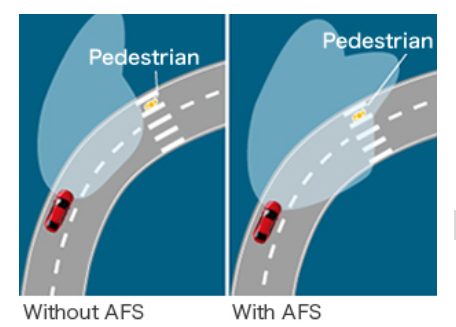What are Adaptive Headlights?
With so many advances in driver safety technology, you might have heard the term adaptive headlights lately. But what exactly are they, and do you need them? Or, are they just another marketing gimmick? This guide will tell you everything you need to know about adaptive headlights in 2020 and beyond.
Adaptive headlights explained
Adaptive headlights are tech-enabled headlights that help improve driver visibility. As the name suggests, they adapt as you drive—but probably not the way you’d think. As you drive, they swivel to point in the same direction as your steering wheel. Traditional headlights don’t do this. This “swivel” can make it easier to see where you’re going, particularly if driving on winding roads or difficult terrain. They’re also often called curve-adaptive headlights or cornering lights.
If you’re having trouble imagining this, check out this video from the Insurance Institute for Highway Safety. You can see how the headlights adjust to illuminate the road where the car has yet to turn onto.
Adaptive vs automatic headlights
The most common misconception about adaptive headlights is that they adapt in brightness, not in direction. Automatic headlights are the ones that will turn on automatically when it’s dark out, but adaptive and automatic headlights are not the same thing. Sometimes, these words are used interchangeably by car salespeople or in marketing materials, so it can get confusing when you’re shopping for a car. When in doubt, you can always ask for a definition or do additional research.
Benefits
The benefit of adaptive headlights is that you have somewhat better visibility when driving around curves, bends and sharp turns at night in low lighting conditions. This is pretty specific. If you rarely find yourself driving at night on winding roads, they might not be a huge benefit to you personally.
Let’s say you’re driving on a dark and winding country road, and you’re coming up on a sharp curve. With traditional headlights, you won’t have visibility as to what’s in front of you until the front of your vehicle has turned. With adaptive headlights, you’ll start to get visibility as soon as you move your wheel. It’s a slight difference, but it could mean that you see a deer or other animal sooner—and save you from slamming on the breaks or swerving to avoid something.
Do you need them?
Whether or not adaptive headlights should be a priority when you’re car shopping is ultimately up to you. If you live in the country, or if you’re someone who likes to take road trips or go off-roading, then they will absolutely benefit you. If you’re mostly driving in the city, in well-list conditions, then they’ll probably be less important.
Overall, headlights should be a consideration in your car buying process. They are an essential part of driver safety, no matter where you live or what type of vehicle you’re buying. Whether or not you decide to go with these headlights, make sure you’re getting the right headlights for your car, and that you maintain your headlights over time to prevent cloudy headlights from interfering with your safety.
Cars manufacturers with adaptive headlights in 2020
Today, there are already a wide variety of car manufacturers that offer these upgraded headlights. Here are just a few.
Audi offers xenon-gas headlights that swivel electromechanically to create adaptive light with a luxury car experience.
BMW offers fully adaptive LED headlights as standard on most models, including G05 X5, G06 X6, G07 X7, G11/G12 7 Series LCI and G14/G15/G16 8 Series. See them in action here.
Porsche Dynamic Light System (PDLS)
These high-tech headlights from Porsche are available on all Panamera models, and claim to offer “enhanced near-field, lateral and far-field illumination.”
Mazda AFS (Adaptive Front-lighting System)
As a more affordable option, Mazda offers a great adaptive headlight as part of their comprehensive safety assist features. Mazda markets these as a way to increase driver safety and visibility when driving at night to reduce accidents.

They arrived at Ford in 2020, and are designed to automatically turn on (become adaptive) at just 3 miles-per-hour. Drivers can also choose to turn this feature off entirely, if they prefer.

















Always positive to see increased safety features. A car today is significantly safer than a car from even a decade ago.
I believe very car should have adaptive headlights not matter if they don’t drive as much. Honestly I have seen people drive horrible and if you cant see them its even harder to prevent an accident. With adaptive headlight the driver not only has a better vision but the other drivers also would see you ahead of time. I wish they werent so expensive.
I would have loved to have had these back when I lived in New Jersey. I hope they become more available on other brands, since they are a huge safety feature. I can see if it being a very niche feature to some people, but a huge benefit to night drivers in Rural areas.
Adaptive lights are awesome. I love them on my Car !
The adaptive headlights are a great upgrade, I love them on our car.
When I first heard of adaptive lights, I marveled at the new technology. This seemed to be a feature with luxury lights only. But now this is becoming a more common feature.